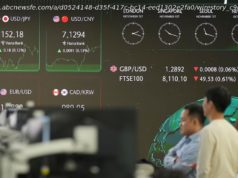As interest rates increase, economists fear that a recession remains inevitable.
The Federal Reserve’s move Wednesday to raise its key rate by a half-point brought it to a range of 4.25% to 4.5%, the highest level in 14 years.
The Fed’s latest increase – its seventh rate hike this year – will make it even costlier for consumers and businesses to borrow for homes, autos and other purchases. If, on the other hand, you have money to save, you’ll earn a bit more interest on it.
Wednesday’s rate hike, part of the Fed’s drive to curb high inflation, was smaller than its previous four straight three-quarter-point increases. The downshift reflects, in part, the easing of inflation and the cooling of the economy.
As interest rates increase, many economists say they fear that a recession remains inevitable – and with it, job losses that could cause hardship for households already badly hurt by inflation.
Here’s what to know:
The short answer: Inflation. Over the past year, consumer inflation in the United States has clocked in at 7.1% – the fifth straight monthly drop but still a painfully high level.
The Fed’s goal is to slow consumer spending, thereby reducing demand for homes, cars and other goods and services, eventually cooling the economy and lowering prices.
Fed Chair Jerome Powell has acknowledged that aggressively raising interest rates would bring “some pain” for households but that doing so is necessary to crush high inflation.
Anyone borrowing money to make a large purchase, such as a home, car or large appliance, will take a hit, according to Scott Hoyt, an analyst with Moody’s Analytics.
“The new rate pretty dramatically increases your monthly payments and your cost,” he said. “It also affects consumers who have a lot of credit card debt – that will hit right away.”
That said, Hoyt noted that household debt payments, as a proportion of income, remain relatively low, though they have risen lately. So even as borrowing rates steadily rise, many households might not feel a much heavier debt burden immediately.
“I’m not sure interest rates are top of mind for most consumers right now,” Hoyt said. “They seem more worried about groceries and what’s going on at the gas pump. Rates can be something tricky for consumers to wrap their minds around.”
Even before the Fed’s latest move, credit card borrowing rates had reached their highest level since 1996, according to Bankrate.com, and these will likely continue to rise.
And with prices still surging, there are signs that Americans are increasingly relying on credit cards to help maintain their spending. Total credit card balances have topped $900 billion, according to the Fed, a record high, though that amount isn’t adjusted for inflation.
John Leer, chief economist at Morning Consult, a survey research firm, said its polling suggests that more Americans are spending down the savings they accumulated during the pandemic and are using credit instead. Eventually, rising rates could make it harder for those households to pay off their debts.
Those who don’t qualify for low-rate credit cards because of weak credit scores are already paying significantly higher interest on their balances, and they’ll continue to.






